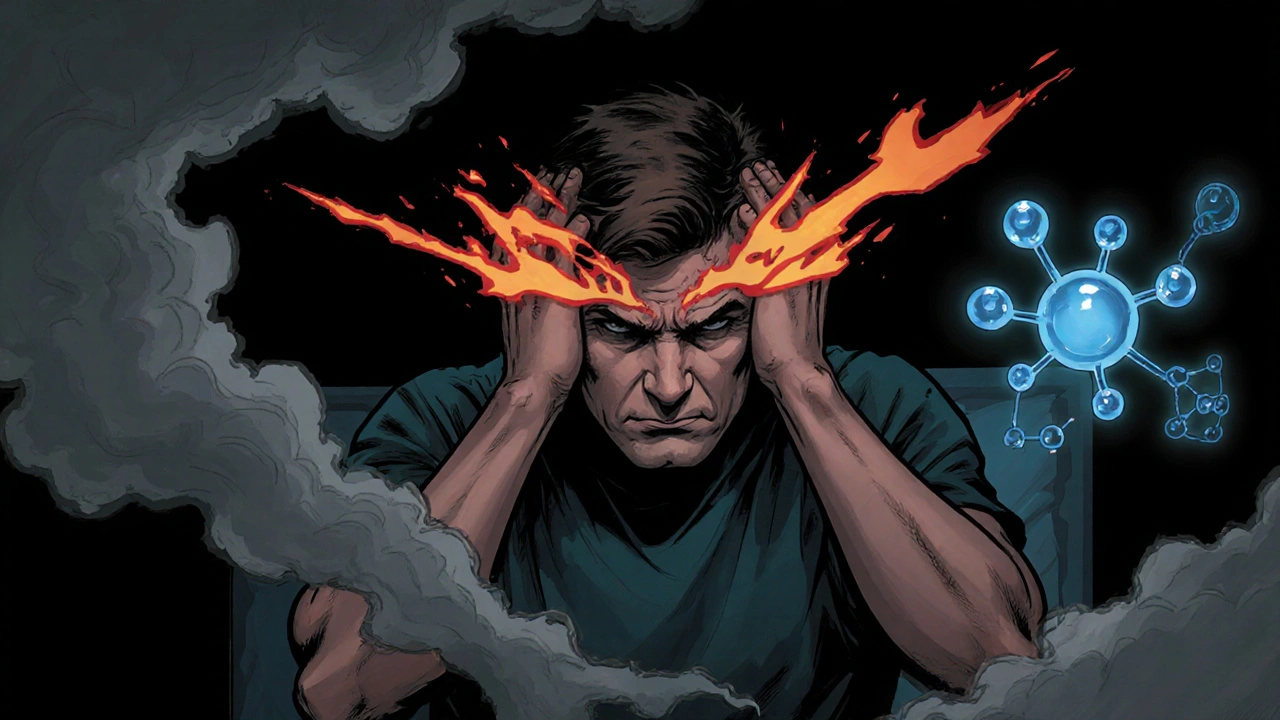Headache & Mood Tracker
Log Your Episode
Patterns & Insights
Ever wonder why a pounding headache sometimes feels like more than just a physical ache? headaches and mental health often walk hand‑in‑hand, influencing each other in ways that can trap you in a vicious cycle.
What a Headache Actually Is
When you feel a headache is a painful sensation in the head that can vary in intensity, location and duration, the brain is sending a distress signal. The pain may sit behind the eyes, throb on one side, or tighten like a band around the skull. Recognising the pattern helps you figure out whether it’s a one‑off tension flare‑up or something that needs deeper attention.
Common Types of Headaches and Their Mental Health Links
Three main headache families dominate the landscape:
- Migraine is a recurrent, often throbbing headache accompanied by nausea, visual disturbances and heightened sensitivity to light or sound. Studies show people with migraines are 2‑3 times more likely to develop depression or anxiety.
- Tension‑type headache is a steady, pressure‑like pain that usually affects both sides of the head. Chronic tension‑type sufferers frequently report stress‑related mood swings and low‑grade anxiety.
- Cluster headache is a short, excruciating pain that appears around one eye, often at the same time each day. Though rarer, the severe pain spikes are linked to heightened panic‑like responses.
Below is a quick side‑by‑side look at how each type connects to mental health.
| Headache Type | Typical Duration | Key Mental Health Link |
|---|---|---|
| Migraine | 4-72hours | Higher risk of depression & anxiety |
| Tension‑type | 30minutes‑several days | Stress‑related mood swings, mild anxiety |
| Cluster | 15‑180minutes per episode | Panic‑like responses, occasional depressive episodes |

Why the Brain Links Pain and Mood
Two chemical messengers play starring roles:
- Serotonin is a neurotransmitter that regulates mood, sleep and pain perception. Low serotonin levels can trigger both migraine attacks and depressive episodes.
- Cortisol is a stress hormone that spikes during emotional turmoil and can sensitize pain pathways. Chronic cortisol elevation is a common denominator in tension‑type headaches and anxiety disorders.
Brain imaging studies show that the same regions-like the trigeminovascular system and the limbic cortex-light up during both severe pain and emotional distress. In plain terms, the nervous system doesn’t draw a strict line between a hurting head and a hurting mind.
When to Seek Professional Help
If you notice any of the following, it’s time to book an appointment with a primary care physician is a medical professional who can evaluate headache patterns and screen for mental health concerns:
- Headaches that appear more than three times a week and last longer than a day.
- Sudden changes in headache intensity, location or accompanying visual symptoms.
- Feelings of hopelessness, loss of interest, or persistent anxiety that overlap with headache episodes.
- Using over‑the‑counter painkillers more than two days a week for a month (possible medication‑overuse headache).
Early intervention can prevent a simple headache from spiralling into chronic pain and a prolonged mood disorder.
Managing Headaches While Supporting Mental Health
Here are practical habits that hit both targets:
- Sleep hygiene: Aim for 7‑9hours, keep the bedroom dark, and avoid screens an hour before bed. Consistent sleep reduces cortisol spikes and cuts migraine frequency.
- Hydration and nutrition: Dehydration and skipping meals are common migraine triggers. Balanced meals with magnesium‑rich foods (nuts, leafy greens) support nerve function.
- Stress‑reduction toolkit: Simple breathing exercises, short walks, or a five‑minute body scan can lower cortisol within minutes.
- Physical activity: Moderate aerobic workouts, like cycling or swimming, release endorphins that act as natural painkillers and mood boosters.
- Limit caffeine and alcohol: Both can provoke migraine attacks and disrupt sleep, feeding anxiety cycles.
Tracking your headaches in a diary-note time, triggers, mood, sleep quality-creates a pattern you can share with healthcare providers.
Treatment Options That Address Both Pain and Mood
When lifestyle tweaks aren’t enough, several therapies target the shared pathways:
- Cognitive‑behavioral therapy (CBT) is a psychological treatment that helps reframe negative thoughts and develop coping strategies for stress and pain. CBT has proven effective in reducing headache frequency and alleviating depression symptoms.
- Prescription medications such as tricyclic antidepressants (e.g., amitriptyline) serve a dual purpose-modulating serotonin and dampening pain signals.
- For migraine‑specific relief, calcitonin gene‑related peptide (CGRP) inhibitors lower attack rates and may improve quality of life, indirectly easing anxiety.
- Biofeedback and mindfulness‑based stress reduction teach the brain to regulate physiological responses, lowering both cortisol output and headache severity.
Choosing the right mix often involves trial and error under medical supervision.
Quick Checklist to Keep You on Track
- Record headache onset, length, location, and accompanying mood.
- Identify at least one daily stress‑relief habit (e.g., 5‑minute breathing).
- Maintain regular sleep and meal schedules.
- Schedule a check‑up if headaches or mood changes persist beyond two weeks.
- Consider talking to a therapist if anxiety or sadness feels overwhelming.
Frequently Asked Questions
Can stress alone cause migraines?
Stress can trigger migraine attacks, especially when it leads to hormonal shifts or poor sleep. Managing stress reduces the likelihood of an attack, but genetics and other factors also play a role.
Is it normal to feel anxious during a headache?
Yes. The pain itself activates the brain’s alarm system, which can spike anxiety. If the anxiety lingers after the pain eases, it may be worth discussing with a healthcare provider.
What’s medication‑overuse headache?
Using painkillers (like ibuprofen or triptans) more than two days a week for several weeks can make the brain become dependent on them, turning occasional pain into a daily problem. Tapering under medical guidance usually resolves it.
Can CBT really lower headache frequency?
Clinical trials show CBT reduces the number of migraine days by up to 30% for many patients, largely by teaching better stress handling and sleep hygiene.
When should I consider seeing a mental‑health professional?
If you notice persistent sadness, loss of interest, panic attacks, or if your headache pattern worsens during periods of low mood, a therapist or psychiatrist can help untangle the two issues.

Jeff Ceo
August 10, 2025
I've been around the block enough to know when a post starts sounding like a self‑help fluff piece, so let me cut to the chase: headaches and mental health are seriously linked, and ignoring the connection is just lazy. You can’t pretend the pain is only “in your head” when your brain is literally screaming in chemical distress. If you’re looking for a quick fix, stop guzzling caffeine and start tracking your mood alongside those throbbing episodes-data beats guesswork every time. And don’t you dare dismiss therapy as “just talking”; CBT has real evidence behind it for cutting migraine days. Bottom line: take this seriously or keep paying for over‑the‑counter meds that won’t fix the root cause.
David Bui
September 1, 2025
look man you read this article and think you’re some kinda expert on headaches but you missed the whole point its not just about popping pills its about stress and sleep see you need a real plan not just fluff advice the author could've been more precise about serotonin levels and cortisol spikes also stop using half‑hearted bullet points they make it look lazy
Alex V
September 23, 2025
Oh yeah, because the big pharma cartel definitely wants you to believe that a simple breath‑work routine will cure your migraines – as if they didn’t already flood the market with overpriced triptans that keep you dependent. The article tries to sound scientific, but let’s be real: “serotonin” is just a buzzword they throw around to make you think you’re getting cutting‑edge care. If you actually read between the lines, you’ll see the hidden agenda – more appointments, more prescriptions, more profit. So next time you feel that pounding throb, maybe question who’s really benefiting from your suffering, not just the “mental health” narrative they push.
Patrick Nguyen
October 15, 2025
Proper sleep hygiene alone can halve migraine frequency.